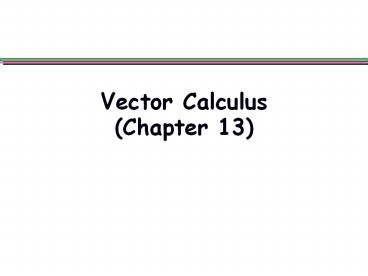Vector Calculus (Chapter 13) - PowerPoint PPT Presentation
1 / 14
Title:
Vector Calculus (Chapter 13)
Description:
(Chapter 13) Vector Calculus F(x,y)= Scalar Fields and Vector Fields The simplest possible physical field is the scalar field. It represents a function ... – PowerPoint PPT presentation
Number of Views:705
Avg rating:3.0/5.0
Title: Vector Calculus (Chapter 13)
1
Vector Calculus(Chapter 13)
2
Vector Calculus
Chapter
13
13.2-13.3
13.4
13.1
ScalarFields, 2D VectorFields
Gradient VectorFields
LineIntegrals
GreensTheorem
3
F(x,y)ltP(x,y),Q(x,y)gt
4
Scalar Fields and Vector Fields
- The simplest possible physical field is the
scalar field. - It represents a function depending on the
position in space. A scalar field is
characterized at each point in space by a single
number. - Examples of scalar fields
- temperature, gravitational potential,
electrostatic potential (voltage)
5
Scalar Fields Visualization of zV(x,y)
- Scalar potential function for a dipole V(x,y)
6
(No Transcript)
7
Maple commands
8
Scalar Fields and Equipotential Lines
- The level curves or contours of the function
zV(x,y) are the equipotential lines of the
scalar potential field V(x,y)
9
The Gradient defines a Vector Field (the force
field)
10
Arrow Diagram for Vector Field
11
Direction Field (magnitude1)
12
(No Transcript)
13
Equipotential surfaces are orthogonal to the
electric force field
Notice the force field is directed towards
placeswhere the potential V is lower, e.g.,
where thecharge is negative - at(0.25,0).But
mathematically,the gradient points in the
opposite direction (greatest ascent) which is
why f-Vand Fgrad(f)grad(-V)
14
2D vector field visualization of the flow field
past an air foil using arrows

